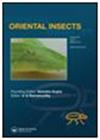New records of the Fluffy Tit butterfly, Hypolycaena amasa Hewitson, [1865] (Lepidoptera: Lycaenidae: Theclinae), from Macau and Hong Kong
IF 0.6
4区 农林科学
Q4 ENTOMOLOGY
引用次数: 1
Abstract
ABSTRACT The first records of the iconic lycaenid butterfly Hypolycaena amasa amasa Hewitson, [1865], commonly known as Fluffy Tit, from Macau and Hong Kong are reported here, along with its other Chinese records. A review on the knowledge of this species across its full distribution range reveals poor information on the larval food plants, in particular. In Hong Kong, early life stages have been found grazing only on the indigenous and widespread plant Clerodendrum cyrtophyllum Turcz. (Verbenaceae). While it is possible that its sudden presence in Macau and Hong Kong, some 150 km southeast of its previously known range, may be related to artificial transport of ornamental plants from mainland China, the fact that the immature stages selectively utilised only C. cyrtophyllum as host, while ignoring completely congeneric ornamental plants species of exotic origin (i.e., C. japonicum (Thumb.) Sweet and C. thomsonae Balf.), indicates that support for this hypothesis is highly unlikely. Therefore, this may represent a new case of poleward migration of species in response to environmental fluctuations related to ongoing climatic changes, global warming in particular. It is now important to monitor these colonies and establish whether they are able to survive in the medium to long term.毛山蝶新记录,Hypolycaena amasa Hewitson,[1865](鳞翅目:毛山蝶科:毛山蝶科),澳门及香港
摘要本文报道了澳门和香港首次记录的标志性lycaenid蝴蝶Hypolycaena amasa amasa Hewitson,[1865],俗称毛绒绒山雀,以及其他中国记录。对该物种在其整个分布范围内的知识的回顾表明,特别是对幼虫食物植物的信息贫乏。在香港,发现早期生命阶段只以本地和广泛分布的植物Clerodendrum cyrtophyllum Turcz为食。(马鞭草科)。虽然它突然出现在澳门和香港,距离以前已知的范围东南约150公里,可能与中国大陆的观赏植物人工运输有关,但事实上,它的未成熟阶段选择性地只利用C. cyrtophyllum作为寄主,而忽略了完全同源的外来观赏植物物种(如C. japonicum (Thumb))。Sweet和C. thomsonae half .)的研究表明,这一假设极不可能得到支持。因此,这可能是物种为应对与持续的气候变化,特别是全球变暖有关的环境波动而向极地迁移的新情况。现在重要的是监测这些蜂群,并确定它们是否能够在中长期内生存。
本文章由计算机程序翻译,如有差异,请以英文原文为准。
求助全文
约1分钟内获得全文
求助全文
来源期刊

Oriental Insects
生物-昆虫学
CiteScore
1.60
自引率
0.00%
发文量
34
审稿时长
>12 weeks
期刊介绍:
Oriental Insects is an international, peer-reviewed journal devoted to the publication of original research articles and reviews on the taxonomy, ecology, biodiversity and evolution of insects and other land arthropods of the Old World and Australia. Manuscripts referring to Africa, Australia and Oceania are highly welcomed. Research papers covering the study of behaviour, conservation, forensic and medical entomology, urban entomology and pest control are encouraged, provided that the research has relevance to Old World or Australian entomofauna. Precedence will be given to more general manuscripts (e.g. revisions of higher taxa, papers with combined methodologies or referring to larger geographic units). Descriptive manuscripts should refer to more than a single species and contain more general results or discussion (e.g. determination keys, biological or ecological data etc.). Laboratory works without zoogeographic or taxonomic reference to the scope of the journal will not be accepted.
 求助内容:
求助内容: 应助结果提醒方式:
应助结果提醒方式:


